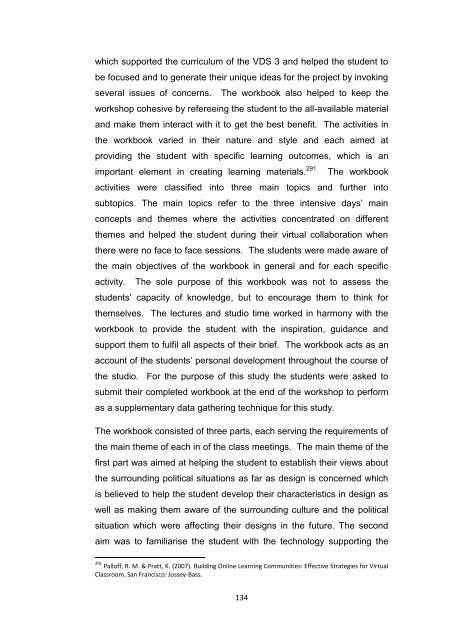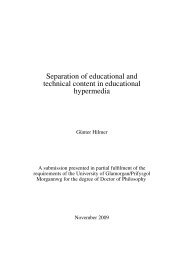framework for the implementation of a virtual design studio model in ...
framework for the implementation of a virtual design studio model in ...
framework for the implementation of a virtual design studio model in ...
You also want an ePaper? Increase the reach of your titles
YUMPU automatically turns print PDFs into web optimized ePapers that Google loves.
which supported <strong>the</strong> curriculum <strong>of</strong> <strong>the</strong> VDS 3 and helped <strong>the</strong> student to<br />
be focused and to generate <strong>the</strong>ir unique ideas <strong>for</strong> <strong>the</strong> project by <strong>in</strong>vok<strong>in</strong>g<br />
several issues <strong>of</strong> concerns. The workbook also helped to keep <strong>the</strong><br />
workshop cohesive by referee<strong>in</strong>g <strong>the</strong> student to <strong>the</strong> all-available material<br />
and make <strong>the</strong>m <strong>in</strong>teract with it to get <strong>the</strong> best benefit. The activities <strong>in</strong><br />
<strong>the</strong> workbook varied <strong>in</strong> <strong>the</strong>ir nature and style and each aimed at<br />
provid<strong>in</strong>g <strong>the</strong> student with specific learn<strong>in</strong>g outcomes, which is an<br />
important element <strong>in</strong> creat<strong>in</strong>g learn<strong>in</strong>g materials. 291 The workbook<br />
activities were classified <strong>in</strong>to three ma<strong>in</strong> topics and fur<strong>the</strong>r <strong>in</strong>to<br />
subtopics. The ma<strong>in</strong> topics refer to <strong>the</strong> three <strong>in</strong>tensive days‟ ma<strong>in</strong><br />
concepts and <strong>the</strong>mes where <strong>the</strong> activities concentrated on different<br />
<strong>the</strong>mes and helped <strong>the</strong> student dur<strong>in</strong>g <strong>the</strong>ir <strong>virtual</strong> collaboration when<br />
<strong>the</strong>re were no face to face sessions. The students were made aware <strong>of</strong><br />
<strong>the</strong> ma<strong>in</strong> objectives <strong>of</strong> <strong>the</strong> workbook <strong>in</strong> general and <strong>for</strong> each specific<br />
activity. The sole purpose <strong>of</strong> this workbook was not to assess <strong>the</strong><br />
students‟ capacity <strong>of</strong> knowledge, but to encourage <strong>the</strong>m to th<strong>in</strong>k <strong>for</strong><br />
<strong>the</strong>mselves. The lectures and <strong>studio</strong> time worked <strong>in</strong> harmony with <strong>the</strong><br />
workbook to provide <strong>the</strong> student with <strong>the</strong> <strong>in</strong>spiration, guidance and<br />
support <strong>the</strong>m to fulfil all aspects <strong>of</strong> <strong>the</strong>ir brief. The workbook acts as an<br />
account <strong>of</strong> <strong>the</strong> students‟ personal development throughout <strong>the</strong> course <strong>of</strong><br />
<strong>the</strong> <strong>studio</strong>. For <strong>the</strong> purpose <strong>of</strong> this study <strong>the</strong> students were asked to<br />
submit <strong>the</strong>ir completed workbook at <strong>the</strong> end <strong>of</strong> <strong>the</strong> workshop to per<strong>for</strong>m<br />
as a supplementary data ga<strong>the</strong>r<strong>in</strong>g technique <strong>for</strong> this study.<br />
The workbook consisted <strong>of</strong> three parts, each serv<strong>in</strong>g <strong>the</strong> requirements <strong>of</strong><br />
<strong>the</strong> ma<strong>in</strong> <strong>the</strong>me <strong>of</strong> each <strong>in</strong> <strong>of</strong> <strong>the</strong> class meet<strong>in</strong>gs. The ma<strong>in</strong> <strong>the</strong>me <strong>of</strong> <strong>the</strong><br />
first part was aimed at help<strong>in</strong>g <strong>the</strong> student to establish <strong>the</strong>ir views about<br />
<strong>the</strong> surround<strong>in</strong>g political situations as far as <strong>design</strong> is concerned which<br />
is believed to help <strong>the</strong> student develop <strong>the</strong>ir characteristics <strong>in</strong> <strong>design</strong> as<br />
well as mak<strong>in</strong>g <strong>the</strong>m aware <strong>of</strong> <strong>the</strong> surround<strong>in</strong>g culture and <strong>the</strong> political<br />
situation which were affect<strong>in</strong>g <strong>the</strong>ir <strong>design</strong>s <strong>in</strong> <strong>the</strong> future. The second<br />
aim was to familiarise <strong>the</strong> student with <strong>the</strong> technology support<strong>in</strong>g <strong>the</strong><br />
291 Pall<strong>of</strong>f, R. M. & Pratt, K. (2007). Build<strong>in</strong>g Onl<strong>in</strong>e Learn<strong>in</strong>g Communities: Effective Strategies <strong>for</strong> Virtual<br />
Classroom. San Francisco: Jossey-Bass.<br />
134



